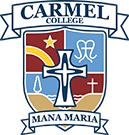While writing last week’s newsletter, final preparations for Carmel Day were being made. Now, it is with a huge sense of warmth and pride that I reflect on the events of last Thursday, not only on the college’s feast day, but also the afternoon performances.
This year the school gym came alive as each House performed their Carmel Day dance based on movie genres. The performances were outstanding, and it is important to acknowledge the huge amount of time and effort that House leaders put into preparing for Carmel Day. The engagement from all involved, the courage that all found to get up and perform, students and staff alike, was truly phenomenal and highlighted the passion and commitment that our young women have to embrace and celebrate what it means to be a part of our Carmel community.
At assembly on Wednesday, we had a timely visit from Constable Murray Fenton who spoke to students about being safe, particularly online. We are aware that without the structure of a daily routine there is the potential for more time online during a term break, and invited Constable Fenton in to ensure our students are fully aware of how to be safe online, and what to do if they require support.
Constable Fenton explained the purpose of the Harmful Digital Communications Act 2015 (HDCA) – to deter, prevent and mitigate harm caused by digital communications, whilst assisting any victims with efficient means of redress. He identified that there are 10 key communication principles which guide the HDCA. These principles state that digital communications should not:
- Disclose sensitive personal facts;
- Be threatening, intimidating, menacing;
- Be grossly offensive;
- Be indecent or obscene;
- Be used to harass an individual;
- Make a false allegation;
- Contain information published in breach of confidence;
- Incite or encourage anyone to send a harmful message to an individual;
- Incite or encourage an individual to commit suicide;
- Belittle someone because of their colour, race, ethnic or national origins, religion, gender, sexual orientation, or disability.
Should anyone encounter any of the above, there are specific actions that can be taken by students and parents to escalate a matter involving harmful digital communication. The main bodies to support further action are Netsafe and the Police, and anyone can make a complaint to Netsafe at any time.
On this note, it is important to draw your attention to a section in today’s newsletter from ‘Safe on Social’ around protecting your children from the dangers of Tiktok. I encourage you to read this with your daughter as the information, while Tiktok specific, relates to other online social media platforms as well. The key message I took from this article is that establishing positive, clear and honest communication with our young people is essential so that when they face issues online, they feel safe and confident to talk to and seek support from their trusted adults. Navigating technology is challenging as the pace of change is rapid. Having open conversations around risks and where to seek support is vitally important.
As we head into the term break, I ask that you continue to support our young women by engaging and talking with them about online and social media platforms, and to also encourage them to reflect on what has worked well this term and what hasn’t, and look at reasons why. By reflecting and discussing the highs and lows of the last 10 weeks, there are opportunities to learn and develop strategies which can then be put into practice as our students prepare for Term 3.
I challenge our students over the next two weeks to find a balance between rest and recuperation, and preparation and self improvement. Yes, our girls need to have a break, but they also need to ensure that each day they are doing at least 30 minutes of physical activity, at least 30 minutes of reading, and unplugging from devices at least 30 minutes before bed to ensure they return to school reinvigorated, refreshed and ready to make the most of the continuing opportunities the college has to offer.

